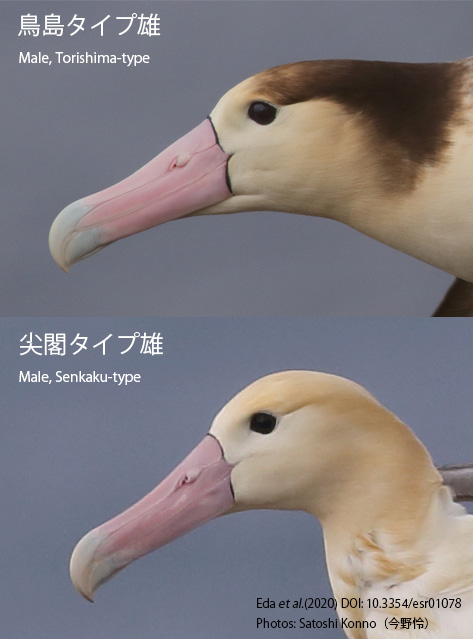
Locations of Short-tailed Albatross breeding sites from the publication. Note the Senkaku/Diaoyu/Tiaoyutai Islands are disputed territory
Masaki Eda (The Hokkaido University Museum, Sapporo, Japan) and colleagues have published open access in the journal Avian Conservation and Ecology on genetic aspects of two populations of Vulnerable Short-tailed Albatrosses Phoebastria albatrus


Access earlier publications by Masaki Eda on the genetics of Short-tailed Albatrosses
The paper’s abstract follows:
“When secondary contact occurs between allopatric sister species, several evolutionary consequences are expected, such as reinforcement of reproductive isolation, hybrid speciation, de-speciation, introgressive hybridization, or formation of a stable hybrid zone. The Short-tailed Albatross (Phoebastria albatrus) is a vulnerable seabird that breeds mainly in Torishima, the Izu Islands, and two islets in the Senkaku Islands in the western North Pacific. Recent studies revealed that Short-tailed Albatross comprises two cryptic species (Senkaku-type and Torishima-type) that breed sympatrically on Torishima. Ringed (hatched in Torishima) and unringed (probably hatched in the Senkaku Islands) birds mate in a mutually assortative manner at the Hatsunezaki colony (artificially established in 1995) on Torishima. However, observations of some ringed–unringed pairs suggest possible hybridization between the two cryptic species. To clarify the degree of hybridization, we analyzed microsatellite DNA and mitochondrial DNA control region 2 (CR2) sequences of chicks from Hatsunezaki and Tsubamezaki (original colony discovered in 1951) colonies and of unringed birds from Hatsunezaki. In general, both CR2 sequences and microsatellites revealed genetic differentiation between immigrants from the Senkaku Islands (unringed birds) and chicks hatched in Tsubamezaki. These findings support the existence of two cryptic species. Each chick obtained from four ringed–unringed parent pairs at Hatsunezaki displayed a high proportion of alleles from just a single population. In contrast, some chicks in Tsubamezaki had a medium proportion of alleles from both populations. Breeding unringed subadult plumage birds, which were probable immigrants from the Senkaku Islands, were observed in Hatsunezaki but not in Tsubamezaki. Therefore, we propose that interspecific pairing occurred in the past but infrequently in recent generations on Torishima, suggesting historical reinforcement of reproductive isolation. Further microsatellite DNA studies of chicks from Hatsunezaki are required to confirm whether reinforcement of reproductive isolation is achieved. Alternatively, nearly complete pre-mating isolation between the two species was established in the past, but the scarcity of Senkaku-type birds in Torishima has facilitated hybridization.”
Reference:
Eda, M., Izumi, H., Konno, S. Konno, M., Watanabe, Y. & F. Sato. 2023. Evidence of historical pairing between two cryptic species of Short-tailed Albatross. Avian Conservation and Ecology 18(1): 3.
23 May 2024

 English
English  Français
Français  Español
Español